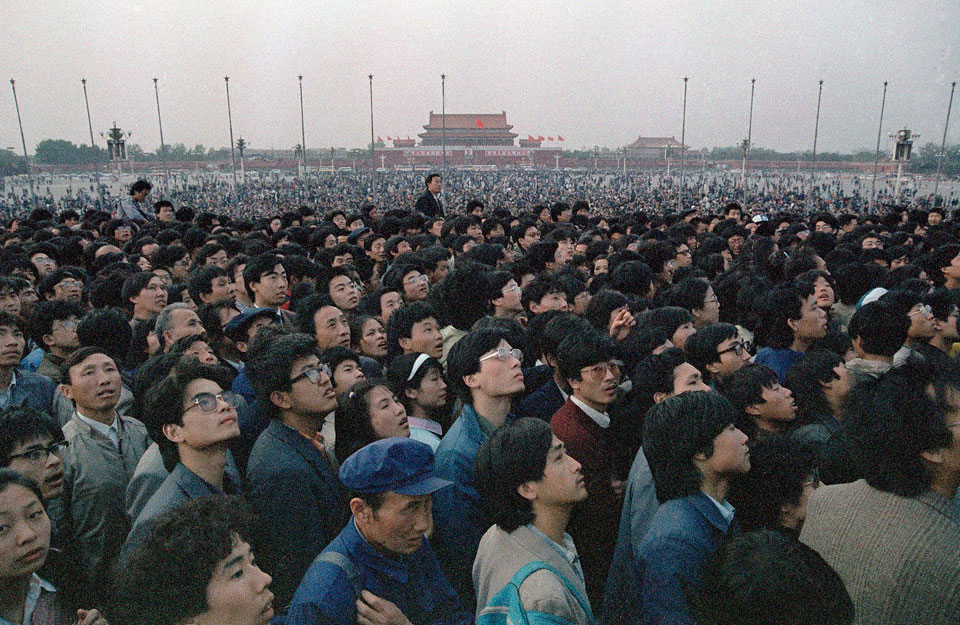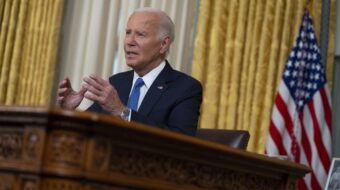
Carl Bloice (1939-2014), then the associate editor and Moscow correspondent of People’s Daily World, was in Beijing in the summer of 1989 during the USSR-China summit. While there, he went to Tiananmen Square and talked with demonstrators who were demanding an end to corruption and greater democracy. Students first started to gather in the square in mid-April following the death of Communist Party leader Hu Yaobang, a symbol of the country’s political and economic reforms. A more rapid move toward democratization was chief among their demands. Eventually, workers from around Beijing joined in the demonstrations, adding their concerns about inflation and corruption to the list of grievances. They would occupy the square until the evening of June 3-4, when soldiers cleared the square and other Beijing streets using armed force. An unknown number of demonstrators were killed. This report, written by Bloice partially before and partially after what has become known as “the June incident” was published in People’s Daily World on June 6, 1989.
BEIJING—For four days, I had real troubles getting past the successive human barricades that ringed the large statue in the middle of Tiananmen Square. Student leaders were in the center and security was tight. On the fifth night, I arrived with a Chinese-speaking colleague. He explained what newspaper I was with. The lines parted. After we passed one checkpoint, the two men guarding it shouted, “Welcome comrade!”
Trying to make my way through such a crowd in other places I have been would have been frightening. Yet I wandered through this crowd—which at one time swelled to nearly two million people—almost without being noticed. Some people maneuvered to get close enough to read the press badge hanging from my neck. There were no signs of anger and not even a hint of violence.
There was the constant chanting of slogans and the sound of ambulances taking away hunger strikers who had fainted, wailing far into the night.
For the authorities, it was never a case of handling a revolt, for there was none. What there was, since the start of the dramatic events, was a protest. When troops were first called into the city, they did not clear the streets as ordered, because the protest had evoked a broad response and wide support. Not just a demonstration, but a city would have had to be subdued.
In a real sense, it was not a “student demonstration” after May 16, when hundreds of thousands of local residents of all ages began pouring into the streets either to join the action or to cheer the demonstrators. Early in the morning of May 19, hundreds of thousands of them, using cars, trucks, and their bodies, began to block highways along which troops were poised to advance into the city.
Throughout the demonstration, the central demand raised by the students was for democracy and political reform. Just what they had in mind was not clearly spelled out. The Western media tended to read into the slogans what they wanted to hear. However, it was hard to find a demonstrator arguing for a multi-party system or opposing socialism. Many did support a further definition of the roles of the Party and government. They spoke most frequently of more openness in political affairs and public information, and greater democracy in existing institutions.

The students also frequently charged that some in the country’s leadership were impeding realization of the “four modernizations.” That is the name given to the economic and social reforms which began ten years ago, aiming at establishing closer contacts with the rest of the world and spurring advancements in science, technology, and education.
“The students are not against socialism or the Party, but they are against some people in the leadership,” said a Party functionary at the height of the action. “They are very concerned about corruption…. They have the support of the people in this. But the important thing is that production not be stopped. If that were to happen, it would have terrible consequences.”
But as we spoke, production had already begun to wind down. Workers with good jobs at some of the numerous luxury hotels began to take to the streets on May 17. This action did not involve a basic industry, but tourism is a vital source of foreign currency for the country. While the hotels did not close, bewildered tourists roamed the streets unable to get to the Great Wall because their buses could not leave hotel parking lots. Moreover, public transit, taxi, and trucking workers had already begun to hit the pavement.
By May 19, many more workers had gone on strike, and large rallies were under way almost constantly in neighborhoods where mostly workers live.
While the banners in student-occupied Tiananmen Square still spoke mainly of political reform, economic and anti-corruption slogans came to the fore in street parades as local residents joined in.
Part of a larger crisis
In a sense, it was probably never merely a student demonstration. What transpired in the city in May was only one expression of social tensions that had been building in China for some time and had reached a critical point. The road ahead had become unclear, and the direction to be taken had become a point of contention.
The events that followed the declaration of martial law demonstrated what an outsider could have only surmised before: The demonstration was only part of a larger sharp crisis that extended into the Communist Party.
Party General Secretary Zhao Ziyang had tears in his eyes when he met with hunger strikers in the square on May 19. The next day, having failed to deter the proclamation of martial law, he disappeared from public view. “I came too late, too late,” he told the strikers. “We deserve your criticism, and we are not here to ask for your forgiveness.
“I am too old, but you are still young,” Zhao told the students. “You should live to see the realization of the four modernizations in China.”
After reports that Zhao had resigned, a student leader told me, “This is not something we wanted.”
The decision to quell the demonstration was made by the Standing Committee of the Party Political Bureau. Its meeting was televised and broadcast live to the students in the square.
“The Party and government have pointed out time and time again that the students are kind-hearted and do not want to create turmoil,” Premier Li Peng told the meeting of the Standing Committee and other Beijing Party functionaries. “Instead, these patriotic students hope to promote democracy and overcome corruption, and this is in line with the goals the Party and government have striven to achieve.
“Questions raised by the students have exerted a positive influence on improving the work of the Party and government, but demonstrations, protests, hunger strikes, and other forms of opposition have upset social stability and will not help solve the problem,” Li said.
A number of times in his speech, Li Peng referred to “a very few people” and “the handful of behind-the-scenes people,” who, he said, were fomenting the crisis. He said they were against the Party leadership, socialism, and the constitution.
The impact of reforms
Whatever the eventual outcome of the events will be, the demonstration will have a lasting and profound effect. “What is happening here will go a long way toward determining the future of the country, a young provincial physician told me. The most immediate question is the future of the four modernizations, the reform program. While students adamantly support the program, many of their complaints—and most of those made by others who join in the protests—flow from decisions made under its banner.
“In the countryside, the reforms yielded enormous results in a short time,” said a full-time Party worker. “The land was turned over to the peasant families. They do not own it, and they must share their income with the state and the collective. But it has provided more incentive, and production has risen. The peasants like it.
“It is where the reforms have moved into urban areas that we have encountered major problems. There it is not easy, and there have been negative results. That is why this year we have started the period of consolidation. Now we are taking a good look at what we have done, studying and drawing conclusions for the future.
“The younger generation is impatient. They don’t understand that everything cannot be accomplished at once. They don’t understand that it will take some time to overcome the effects of the Cultural Revolution—the lost decade.”
However, not only have the reforms not solved all major problems, but they have also generated some new ones, including soaring inflation and rising unemployment. Many people have seen their living standard decrease through no fault of their own, while others have lost their incomes entirely. Much of the joblessness is a direct result of the agricultural reforms and a sharp cutback in rural construction.
“Market mechanism” and corruption
At the same time, an element of private enterprise has developed and some people are encouraged to get rich. Such a situation is a specter haunting any socialist country in which the “market mechanism” is given a prominent role. Some people are making sacrifices, while others are raking in money and spending it ostentatiously.
The reforms have also produced an element of corruption. But what has evoked the greatest resentment is not illegality, but profiteering. This is facilitated partly by the existence of two kinds of currency—one of a higher value and available to those who deal abroad or with foreigners.

“The individual traders are not the kind that would raise the prices the way they have risen,” said an office worker. “And yet, the prices of such things as color televisions have gone up greatly…. Some people high up are able to buy at a low price and sell to the dealers at a high price. That’s why the cost of things has gone up, while they make big profits.”
The demonstrators wrote on banners what everybody I spoke to believes: that among those enriching themselves are those with important connections. “The prices of some things have gone up two and even three times,” I was told by an office worker. “My salary has gone up nothing like that. It is because of this that people say, ‘Why is it that we have less money to spend and the sons and grandsons of those in the center are getting rich?’”
When a group of workers joined the demonstration, they brought 12 demands. One was an immediate end to profiteering, another a price freeze.
Of course, it is important that the events in China be kept in demographic perspective. A demonstration by one or even two million people is not an overwhelming event in a country of 1.1 billion. It should also be kept in mind that 68 percent of China’s population lives, not in the cities, but in the countryside, where the realities of life are quite different.
Yet China is a developing country, moving ahead as we approach the last decade of the century. A major part of its resources is the educated youth. They and the rapidly growing working class will play—one or another—the critical role in shaping the country’s future. For now, their exertion of political will has been suppressed. But their concerns have been heard and hopefully listened to.
—
The above lines were written on a train heading for the Democratic People’s Republic of Korea. That was a week before the tragic events of June 3-4. The size of the forces arrayed against the demonstrators illustrates that those who deployed them were aware that more than a student demonstration was involved. The brutality is simply incomprehensible. Nothing I saw in Beijing could justify it.
Now, Tiananmen Square is bloodstained, presumably empty of protesters and quiet, as it was before the students arrived in April. But, as the provincial physician told me, “Whatever happens now, China will not be the same after this.”












Comments